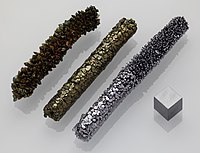
Photo from wikipedia
Vanadyl phosphate (VOPO4 ·2H2 O) has been regarded as one of the most promising cathode materials for aqueous Zn-ion batteries due to its distinct layered structure. However, VOPO4 ·2H2 O… Click to show full abstract
Vanadyl phosphate (VOPO4 ·2H2 O) has been regarded as one of the most promising cathode materials for aqueous Zn-ion batteries due to its distinct layered structure. However, VOPO4 ·2H2 O has not yet demonstrated the exceptional Zn ion storage performance owing to the structural deterioration during repeated charging/discharging process and poor intrinsic conductivity. In this work, 2D sodium vanadyl phosphate (NaVOPO4 ·0.83H2 O, denoted as NaVOP) is designed as a cathode material for Zn-ion batteries, in which sodium ions are preinserted into the interlayer, replacing part of water. Benefiting from the in situ surface oxidization, improved electronic conductivity, and increased hydrophobicity, the NaVOP electrode exhibits a high discharge capacity of 187 mAh g-1 at 0.1 A g-1 after activation, excellent rate capability and enhanced cycling performance with 85% capacity retention after 1500 cycles at 1 A g-1 . The energy storage mechanism of the NaVOP nanoflakes based on the rapid Zn2+ and H+ intercalation pseudocapacitance are investigated via multiple ex situ characterizations.
Journal Title: Small
Year Published: 2023
Link to full text (if available)
Share on Social Media: Sign Up to like & get
recommendations!